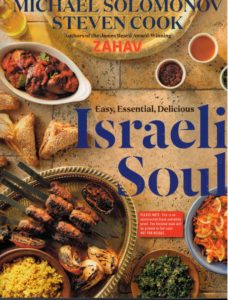By Jerry Levens


SAN DIEGO — Every cookbook has a story and Israeli Soul, the new cookbook by Michael Solomon and Steven Cook has many. It will be released on October 16. Solomon is the head chef at Zahav restaurant in the Society Hill section of Philadelphia, while Cook is involved in its management. The partners’ previous cookbook Zahav: A World of Israeli Cooking won two James Beard awards in 2017; one for Best International Cookbook and one for Cookbook of the Year. Their books are quite interesting with a deep and varied cultural significance. Just as Israel has evolved over the past 70 years, this new cookbook Israeli Soul reflects the Israeli cuisine created from its merged and comingled cultures and food traditions in an “Easy, Essential, Delicious” manner. Some of the recipes, spices, and food preparation methods have been around for well over a millennium. Falafel, hummus, tehini can be traced back to the Pharaohs of ancient Egypt. Eggplants were almost unknown before the 20th century. This book is a very good read above and beyond its “recipes.” The historical content alone is worth the time and effort. Israeli Soul is filled with beautiful photographs showing mouth watering dishes.
I have had a long interest in Middle Eastern cuisine primarily due to my time as a professor of international business and economics at a graduate school in Arizona. Students were from all over the world, with many from India, Lebanon, Saudi Arabia, Egypt, Iran, etc. My wife Rachel and I established a dining “club” to share and cook the students’ favorite native cuisines at their direction. We even organized a campus-wide weekend international festival of goods and food which included worldwide dishes for several thousand. In March 2017, Rachel and our daughter Kelly returned from two weeks touring Israel and experiencing Israeli cuisine anew. As soon as I picked them up at the airport, Rachel started raving about how wonderfully varied, fresh, delicious, and unique the food was. It was the first time in our 48 years together that she was really excited by what she had eaten, except of course for those traditional, Jewish dishes which I prepare at home.
The authors point out in their introduction that the soul of Israeli cuisine reflects the world wide wandering of the Jewish people through numerous cultures and nations. The early Zionist settlers brought foods from their native lands. Kibbutzim established new food traditions fresh from the fields. Other foods reflected Israel’s geography on the Mediterranean Sea, near the spice routes, the fertile crescent, and the African Rift Valley. The creation of the state of Israel in 1948 provided a repository for these culinary traditions which evolved into contemporary Israeli cuisine.
We have room only to sample from the book, which is divided into four main Sections: I – In the Hand, II – At the Table, III – From the Bakery and IV – From the Icebox. The recipes reflect those foods discovered by the authors on their recent travels through Israel. A map lists the locations of the cities where they stopped to sample food. The recipes and photographs mention various restaurants or roadside stands in the country. Each recipe has the list and quantities of ingredients with easy to follow preparation steps. Although several of the herbs and spices may not be familiar to us or readily available at nearby chain grocery stores, the specialty markets in big cities along our east and west coasts will be able to supply a wider variety.
Falafel — originally an Arabic word for chickpeas (garbanzo beans) “falafel” is made of ground peas/beans mixed with herbs and spices and then fried as patties or balls. The authors state that p’Acha (jellied calves feet) is the official national dish of Israel. Yet, Israelis eat tremendous quantities of falafel spurred on by the advanced baking technology that commercialized pita bread. At present, the debate is who makes the best falafel. There are many vendors who lay claim to this distinction. The search almost qualifies as a national obsession. This section also includes a dozen or so pages on tehina sauce variations using other legumes, fresh or dried and salad variations.
Eggplant — Israeli independence in 1948 caused many immigrant Jewish communities from the Middle East to relocate to Israel bringing their unique culinary traditions. Iraqi Jews had a custom of eating on Saturday mornings fried or baked eggplant (sabich) along with hard boiled eggs and tehina. Recipes for both hot and cold varieties of eggplant are included. Since observant Jews do not cook on the Sabbath, their food preparation stops before sundown on Friday. Iraqi Jews assembled T’bit, a stew of meat, grains, and vegetable that would cook overnight on a hot plate for a warm Sabbath lunch
Jerusalem Grill — Hatzot which literally means “midnight,” is a grill restaurant with tables outdoors near Jerusalem’s Machaneh Yehuda Market. It may only be 9 p.m, but it is filled to capacity. Those present are enjoying a pita sandwich of chicken liver and other organ meats grilled with onions and a secret blend of spices. The origin of the “Jerusalem grill” is somewhat vague. Everyone seems to know of it, even if they do not wish to eat it. Schnitzel (German for cutlet or scallop) was one of the first foods that Jews brought to Palestine at the turn of the 20th century. For many German Jewish settlers veal was a preferred ingredient. However, chicken and turkey were more affordable and available in Israel. These meats soon became the preferred schnitzel ingredient driving down the status of veal.
Hummus — Israelis seldom make this favorite at home. Fresh hummus is readily available at hummusiyas, as well as at various markets. It is considered an everyday food with various recipes presented in Israeli Soul. Also included is a wonderful collection of spice blends and sauces such as hawaij, shawarma, harrisa, merquez, muhammara, harrif, and schug. San Diegans may be able to find their ingredients at Trader Joe’s, Whole Foods, Vine Ripe or other Middle Eastern markets locally. These foods can be served on their own, hot or at room temperature, as salads, side dishes, condiments, or even as main dishes. A quick tehini recipe is provided to make hummus, and for use as an important sauce for many recipes in this chapter.
Salads — the book provides eight quick essential salad recipes with ideas for variation. It is important to remember that salads are always prepared with fresh ingredients and can be eaten at any meal. “A wise man once said, ‘You don’t win friends with salad.’ He obviously hadn’t been to Israel yet.” “Salad is both a common denominator of Israeli cuisine as well as a celebration of its diversity.”
Ashkenazi foods — This is the food I grew up with in the US. Ashkenaz was the medieval rabbinic name for Germany, later extended to the lands of Eastern European Yiddish speaking Jews. It was then the peasant cuisine of Poland, Hungary, Russia and, of course, Germany. Many of us in the U.S. consider this to be our Jewish Soul Food: gefilte fish, chopped liver, pastrami, and egg creams. It was out of this geographic group that the Zionist movement emerged a century later to form the State of Israel. In the early 1950’s my parents made their first visit to Israel. My father, a rabbi, could read, write and speak fluent Hebrew. My mother could do the equivalent in Yiddish. It was her language talent that served them best on their longest visits. The book offers many additional recipes and photographs of new adaptations of the Ashkenazi food with a Sephardic influence. The new twist on chopped liver is Chicken Liver Mousse. Rye bread with caraway seed was unknown to Sephardic and Mizrahi Jews. Rye bread never gained a large foothold in Israel. In America however, it is the foundation of our deli sandwiches.
Drinks and Cold Treats – This chapter generates considerable interest as it deals with the origin of seltzer and how seltzer became the “Jewish champagne.” It includes recipes for a variety of fruit syrups to flavored seltzer along with shakes, whips, halva, popsicles, Turkish coffee, dates, and labne.
The photography throughout the book is beautifully done in vibrant colors on almost every page. This publication now holds a very important place of honor among the hundreds of “cookbooks” I have acquired over my life as Chief Family Chef and Caterer. I feel certain that all who enjoy good Jewish food; Israeli, American deli, Eastern European or Middle Eastern, and Sephardic will learn from and enjoy the selection of recipes and preparation of dishes in this remarkable cookbook.
*
Levens is a freelance writer with a broad knowledge of cuisine.
Enjoyed your feature